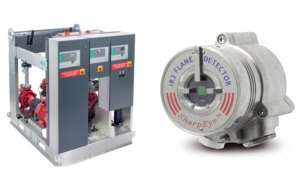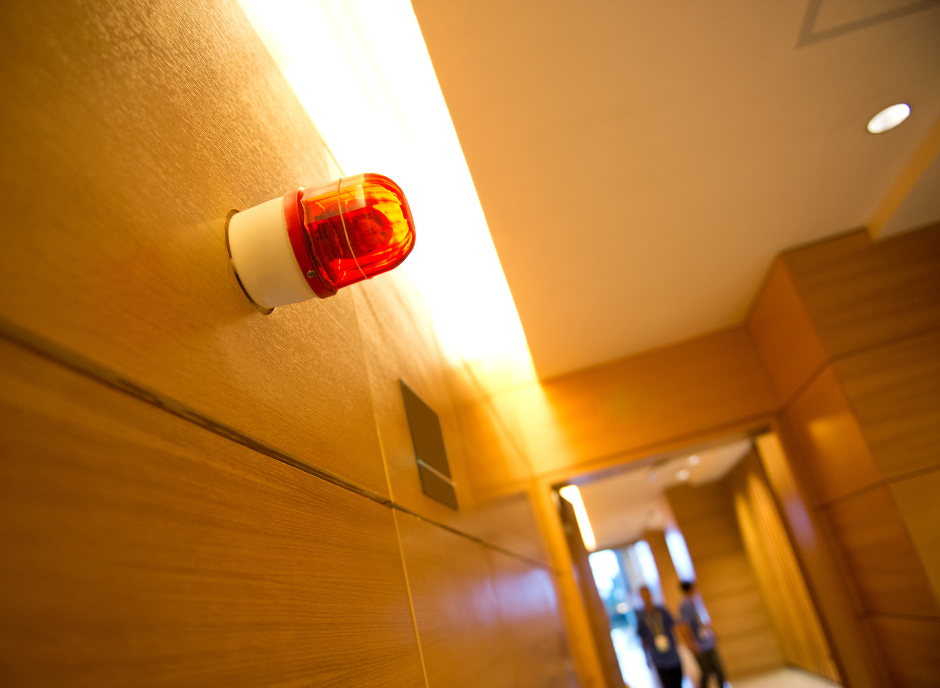Inert gas fire suppression is an ideal solution for protecting sensitive equipment such as in computer server rooms. It offers fast fire control and minimizes collateral damage. Moreover, it is an environmentally friendly alternative. Here we look at what inert gas fire suppression systems are and how they work, the gases used and the role of detectors and alarms.
What Is Inert Gas Fire Suppression?
Inert gas fire suppression relies on flooding a space with naturally occurring gases. It lowers oxygen concentration to a level that cannot support combustion. For example, a typical system reduces ambient oxygen from 21% to below 12%. Consequently, the fire starves for oxygen. This method is residue-free and leaves sensitive electronics unharmed. In addition, it causes no chemical reactions with equipment.
Many engineers prefer this method. It protects data centres, museums, and control rooms. Furthermore, it maintains visibility during and after discharge. The system provides rapid suppression without long clean-up times.
Inert Gases Used in Fire Suppression
The most common inert gases include nitrogen and argon. In addition, some systems blend carbon dioxide with these gases. For instance, the Inergen system uses 52% nitrogen, 40% argon, and 8% carbon dioxide. Moreover, pure nitrogen systems exist and are known as IG-100 systems. Similarly, IG-01 uses pure argon. Alternatively, IG-55 combines 50% nitrogen with 50% argon. Formulations are chosen based on the hazard and the protected equipment.
These gases are non-toxic, colourless, and odourless. They are naturally present in the atmosphere. Consequently, they do not harm equipment or the environment. In addition, they maintain the integrity of sensitive materials. Engineers select the blend based on the balance between suppression efficiency and human safety.
How Inert Gas Systems Work
Inert gas systems work by displacing oxygen from the protected space. When a fire is detected, the system releases the gas into the room. This process occurs rapidly – usually in less than one minute. Furthermore, the system mixes the gas uniformly throughout the area. As a result, the oxygen level falls quickly smothering the fire before it can spread.
The process uses high-pressure cylinders linked to a network of piping. Directional valves ensure that the gas reaches every corner of the enclosure. Additionally, pressure regulators control the flow. This constant flow rate prevents dangerous pressure spikes damaging sensitive equipment.
Moreover, the system is designed for continuous operation. It uses advanced algorithms to determine the exact gas quantity needed. Consequently, the gas concentration meets the design threshold for suppression. In short, the system acts swiftly and accurately to protect equipment.
Detectors and Alarms in Inert Gas Fire Suppression
Early detection is critical for the success of any fire suppression system. Many installations combine inert gas systems with modern detectors. For example, optical smoke detectors can identify small fires in their initial stages. In addition, aspirating smoke detectors, such as VESDA systems, provide continuous monitoring. These detectors sample air continuously. Therefore, they offer an elevated level of sensitivity.
Heat detectors also play a vital role. They trigger the system when temperatures rise sharply. Furthermore, multi-sensor detectors combine smoke and heat detection. Consequently, they reduce false alarms and improve response times.
Alarms are equally important. Audible alarms such as sirens or horns alert personnel immediately. Visual alarms using strobe lights ensure that everyone is aware of the emergency. In addition, modern systems integrate both types for a comprehensive alert. Moreover, some installations include wireless alerts that notify remote operators via mobile devices or emails.
The integration of detectors and alarms ensures that personnel can evacuate safely. Furthermore, they provide an extra layer of security in sensitive environments. Thus, fast detection and reliable notification are essential components of these systems.
Examples of Installations and Case Studies
Inert gas suppression systems have been installed in a wide range of settings. Data centres have widely adopted these systems to protect servers. For example, a major European data centre installed an Inergen system. It successfully extinguished a simulated electrical fire without damaging critical equipment. Consequently, the data centre avoided costly downtime.
Moreover, museums and libraries use inert gas systems to protect priceless artefacts. In one case study, a historical museum deployed an inert gas system. The system was integrated with advanced detectors and alarms. When a test fire was initiated, the system reduced the oxygen level rapidly extinguishing the fire before any damage occurred. Additionally, the museum resumed operations almost immediately. This success has encouraged other cultural institutions to invest in inert gas technology.
Another case involved a control room in a power generation facility. The installation used a pure nitrogen system (IG-100) designed to handle high-risk electrical fires. During a controlled test, the system acted within 45 seconds. Moreover, the alarms alerted staff well in advance. As a result, the facility ensured continuity of operations while maintaining safety.
These examples highlight the reliability and efficiency of inert gas systems. In addition, they demonstrate that the systems are adaptable to various environments. Furthermore, they provide peace of mind to operators who must protect valuable equipment and assets.
Technical Advancements and Future Trends
Recent innovations continue to improve inert gas systems. For instance, advanced pressure regulators maintain constant flow. Moreover, digital monitoring systems now track cylinder pressure and temperature in real time. Consequently, operators receive proactive warnings if gas levels fall below the required threshold.
Furthermore, integration with building management systems is on the rise. This allows for remote monitoring and control of the fire suppression system. In addition, future systems may use artificial intelligence to predict maintenance needs. Therefore, downtime will be reduced even further.
New detection technologies also show promise. For example, multi-sensor detectors now offer faster response times. Consequently, they trigger the suppression system more quickly. Moreover, research into new inert gas blends continues. Engineers hope to improve human safety further while maintaining extinguishing efficiency.
Fire protection experts now recommend inert gas systems for environments where equipment damage is unacceptable. Moreover, they praise the systems for their rapid response and minimal maintenance requirements. Therefore, inert gas fire suppression is set to become the standard for sensitive areas. In summary, the technology offers a powerful solution that balances safety, efficiency, and environmental responsibility.
Firebrand Group offer extensive services covering every stage of fire protection, from conducting Risk Assessment Surveys to designing, supplying, and installing a wide array of Fire Protection Systems. Our expertise ensures that the systems we install are tailored to meet specific needs while maintaining compliance with all relevant standards, including NFPA, FM Global and SANS requirements.
Contact us to discuss your fire protection projects and requirements.






